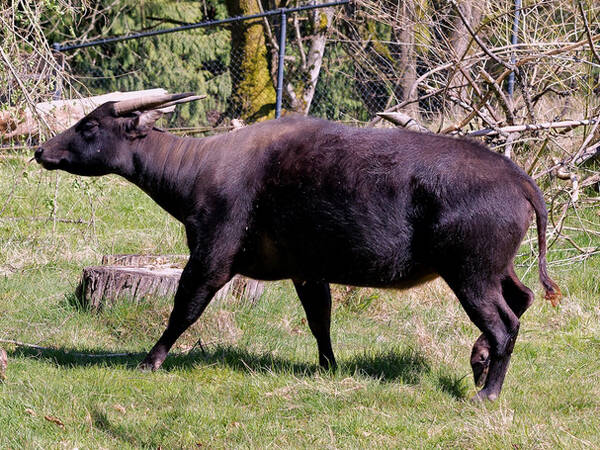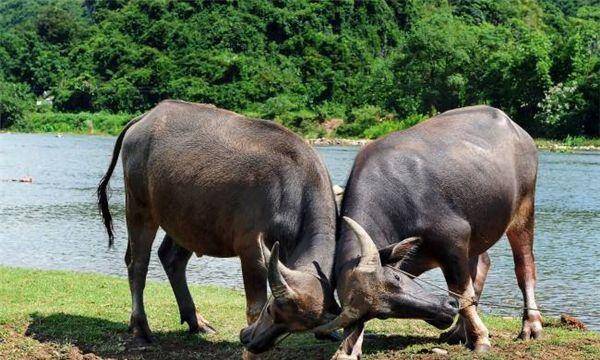Bubalus depressicornis
IUCN
LCBasic Information
Scientific classification
- name:Bubalus depressicornis
- Scientific Name:Bubalus depressicornis,Celebes buffalo, Lowland buffalo
- Outline:Ungulata
- Family:Artiodactyla Bovidae Buffalo
Vital signs
- length:About 180 cm
- Weight:150-300kg
- lifetime:About 20 years
Feature
One of the smallest buffaloes in the world
Distribution and Habitat
It is found only in the northern part of Sulawesi, Indonesia.
It is found mainly in tropical and subtropical areas with high temperatures and humidity. It prefers undisturbed lowland forest areas and swamps. It chooses shady places to avoid the high temperatures during the day. It lives at altitudes from sea level to 1000 meters.
Appearance
The Lowland Buffalo is 180 cm long; 80-90 cm tall at the shoulder; 40 cm long tail; and weighs 150-300 kg. The Lowland Buffalo is one of the smallest buffaloes in the world. The coat is dark brown, with males being darker than females, and the calves are born reddish brown with an orange tint. The Lowland Buffalo has white markings on the head and lower limbs, and a white crescent-shaped mark on the throat. The hindquarters are slightly higher than the shoulders. Both males and females have a pair of dark green right horns that start from the edge of the forehead and point diagonally backwards, 18-37 cm long. The male horns are about 30 cm long, while the females are slightly smaller, about 25 cm, flat, born on the forehead, and the horns point backwards. The horns are very effective when walking through forest brush, and to avoid entanglement, the horns are tightly held behind.
Strong physique; with legs suitable for long-distance running; there are 4 toes on the feet, but the late
Details
Lowland buffalo (scientific name: Bubalus depressicornis) is called Lowland anoa in foreign language, and has no subspecies.

Unlike other wild cattle, Lowland buffalo usually live alone. Mother-child pairs are common, and occasionally small herds of up to 5 are gathered. It is a terrestrial animal. Males use their horns to mark trees and dig the soil after urinating. It is active during the day and evening and rests at noon. Living by the water in tropical plains, lowland buffaloes are afraid of heat, like to soak in water and often roll in muddy water. They are slow to move, usually moving at a slow trot, not good at jumping, and occasionally have clumsy jumps. Even when running, they are slow. When they pass through the bushes, they will put their horns against their necks to prevent being hooked. When pressed by the enemy, lowland buffaloes are very dangerous opponents, and their horns will attack like daggers. Lowland buffaloes are solitary and irritable, especially young buffaloes in estrus.
Lowland buffaloes are herbivores and like to eat the tender branches and leaves of aquatic plants. Wild lowland buffaloes feed on aquatic plants, ferns, grasses, seedlings, fallen fruits, palms and ginger. Additionally, in areas without salt licks or mineral water, they drink seawater to meet their mineral needs. Lowland buffalo in captivity feed on hay and herbivore feed.

Lowland buffalo do not have a breeding season. Both males and females become sexually mature at approximately 2 years of age. Females typically breed annually, with a gestation period lasting 275-315 days, and are left alone when calving. One litter per litter, occasionally twins. Weaning at 6-9 months. Lifespans of up to 31 years have been documented in captivity. However, the maximum lifespan in the wild is about 20 years.
The lowland buffalo is considered endangered because its population is estimated to be less than 2,500 mature individuals, its rate of decline is thought to be greater than 20% in two generations (14-18 years), and no subpopulation has more than 250 mature individuals. Since the lowland buffalo's habitat is more accessible to human activities than the mountain buffalo, the threats to this species and its decline are considered more serious than those of the mountain buffalo.
Listed in Appendix I of the Convention on International Trade in Endangered Species of Wild Fauna and Flora.
Listed in the IUCN Red List of Threatened Species in 2014 ver3.1 - Endangered (EN).
Protect wild animals and eliminate game.
Maintaining ecological balance is everyone's responsibility!








